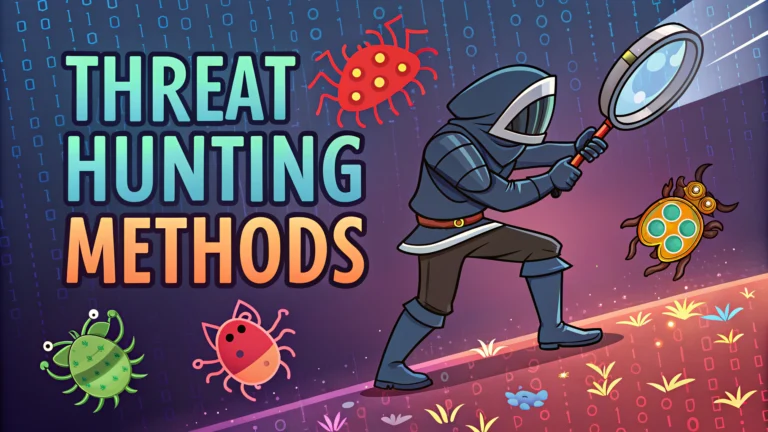Threat hunting through penetration testing requires a structured approach to actively search for potential security breaches and vulnerabilities within networks and systems.
Security teams use various tools, techniques, and methodologies to simulate real-world attacks and uncover hidden threats that automated tools might miss.
This guide covers practical threat hunting methods using penetration testing, from initial reconnaissance to advanced exploitation techniques.
Essential Penetration Testing Tools
- Nmap: Network mapping and port scanning
- Wireshark: Network protocol analysis
- Metasploit Framework: Exploitation and vulnerability testing
- Burp Suite: Web application security testing
- John the Ripper: Password cracking
Reconnaissance Phase
Start with passive information gathering using tools like Maltego and Shodan to collect publicly available data about the target.
Network Enumeration
- Port scanning with Nmap:
nmap -sS -sV target_ip - Service identification
- Operating system detection
- Network topology mapping
Vulnerability Assessment
Use automated scanners like Nessus or OpenVAS to identify known vulnerabilities in systems and applications.
| Tool | Purpose | Best For |
|---|---|---|
| Nessus | Vulnerability scanning | Enterprise environments |
| OpenVAS | Security assessment | Small-medium networks |
Exploitation Techniques
- Buffer overflow attacks
- SQL injection
- Cross-site scripting (XSS)
- Man-in-the-middle attacks
Post-Exploitation
Document findings, maintain access, and gather additional information about compromised systems while staying undetected.
Reporting and Documentation
- Document all findings with screenshots
- Prioritize vulnerabilities based on risk
- Provide remediation steps
- Include technical details for IT teams
Security Recommendations
- Regular penetration testing schedules
- Continuous monitoring systems
- Incident response planning
- Security awareness training
Taking Action
Contact certified penetration testing providers or build an internal security team with relevant certifications (OSCP, CEH, GPEN).
Additional Resources
- OWASP Foundation: https://owasp.org
- Offensive Security: https://www.offensive-security.com
- SANS Institute: https://www.sans.org
Moving Forward with Security
Schedule regular penetration tests, keep tools updated, and maintain documentation of all security assessments for continuous improvement of your security posture.
Advanced Testing Methodologies
- Red Team Operations
- Purple Team Exercises
- Social Engineering Tests
- Physical Security Assessments
Compliance and Regulatory Considerations
Ensure penetration testing aligns with industry regulations such as GDPR, HIPAA, and PCI DSS requirements while maintaining proper documentation of compliance efforts.
Key Compliance Areas
- Data protection standards
- Industry-specific regulations
- Testing scope limitations
- Documentation requirements
Risk Management Integration
Integrate penetration testing results into the broader risk management framework to properly assess and prioritize security investments.
| Risk Level | Response Time | Action Required |
|---|---|---|
| Critical | 24-48 hours | Immediate remediation |
| High | 1 week | Prioritized fix |
| Medium | 1 month | Planned update |
Strengthening Your Security Posture
Implement a continuous security improvement cycle based on penetration testing findings, focusing on both technical controls and organizational processes. Regular assessment and adaptation of security measures ensure robust protection against evolving threats.
- Establish metrics for security improvement
- Develop remediation timelines
- Create feedback loops with development teams
- Update security policies based on findings
FAQs
- What is threat hunting in penetration testing?
Threat hunting is a proactive security approach that involves actively searching for malicious activities or security threats that have evaded existing security solutions within a network. - What are the main methodologies used in threat hunting?
The main methodologies include IoC-based hunting (Indicators of Compromise), TTP-based hunting (Tactics, Techniques, and Procedures), and hypothesis-based hunting, which focuses on theoretical scenarios. - How does threat intelligence integrate with threat hunting?
Threat intelligence provides context and data about known threats, attack patterns, and adversary behaviors, which guides hunters in identifying similar patterns within their environment. - What tools are commonly used in threat hunting?
Common tools include SIEM systems, EDR platforms, network monitoring tools like Wireshark, log analyzers, and specialized threat hunting platforms such as Splunk and ELK Stack. - What is the difference between threat hunting and incident response?
Threat hunting is proactive and searches for hidden threats before they cause damage, while incident response is reactive and deals with known security incidents that have already occurred. - How does machine learning support threat hunting?
Machine learning helps identify anomalies, patterns, and potential threats by analyzing large volumes of data and establishing baseline behaviors to detect deviations. - What are the key indicators hunters look for during threat hunting?
Hunters look for unusual network traffic patterns, suspicious process behavior, unauthorized system changes, abnormal user activity, and known malware signatures. - What is the MITRE ATT&CK framework’s role in threat hunting?
MITRE ATT&CK provides a comprehensive matrix of adversary tactics and techniques, helping hunters understand and identify potential attack patterns and methodologies. - How often should threat hunting be performed?
Threat hunting should be conducted regularly, with continuous monitoring and periodic deep dives, typically quarterly or monthly depending on the organization’s risk profile and resources. - What skills are required for effective threat hunting?
Essential skills include network analysis, log analysis, malware analysis, scripting abilities, understanding of attack methodologies, and knowledge of operating systems and security tools.







